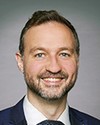Thank you. It's nice to see you again. It's been an honour to testify today, and it's been fascinating to see the debate and the inclusion of a spirited discussion.
In terms of the open licence, our approach to this is that basically everyone involved in the project has been doing it from a humanitarian point of view. We started with a group that is used to working in a very open way. We work in basic science, and that has been a very open topic for years. Even during the Cold War, the sorts of things that were being worked on in basic science were very open in the literature, and I think the whole world has benefited by this approach.
In this particular case, we were looking for something of a humanitarian nature, so we wanted to do it in such a way that companies in other countries could pick up on the particular concept that we have here, which is really a modernization of another formerly used ventilator, a very simple one from the early days, known as the Manley ventilator.
We took the attitude that we would first of all publish the design openly and then the improvements to the design and the testing that goes along with it. None of us wants to attempt to hold IP on this subject. Our manufacturers, of course, are putting in their own specific industrialization, and that's a separate question for them, but any company in the world is capable of taking our design and industrializing it and obtaining certification in the relevant jurisdiction. It's a standard approach in science.




